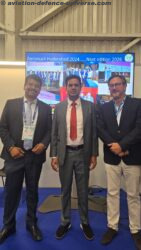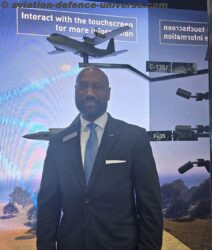- Manned and unmanned teaming
By Lt Gen (DR) Vijay Kumar Saxena, (Retd), PVSM, AVSM, VSM
New Delhi.12 December 2017. Manned and unmanned Teaming or MUM-T for short, basically relates to that win-win situation, in which the human genius of a combat pilot, his (her implied) tolerance for ambiguity, hunch, intuition, experience, instant decision making capability and more, is amalgamated with the brute lethality, long endurance, needle-like precision and all terrain and all weather capability of the modern day Unarmed Aerial Systems (UAS) in joint missions This concept is fast catching up across the leading nations of the world since the initial results show multiplicative and disproportionate gains, albeit not without many a challenges; some operational, some ethical. This work endeavours to update the reader on the cutting edge in MUM-T today and makes a brief statement on a required way forward for India.
The Journey So Far – A Brief Word
- According to an article by Col Thomas Von published in the US Army Aviation Magazine, (Archive 5), not really MUM-T, but something remotely close to it, happened way back in WWII when a B-17 Flying Fortress of the RAF started as a manned bombing mission to bomb a submarine bunker in Germany. After achieving the cruising altitude of 20,000 ft, and arming the explosives, the two-pilot crew parachuted into the English Channel, letting the aircraft fly to its intended target as a robot. The mission failed but a step cousin of MUM-T passed into evolution that would tickle the minds of the inventors in years to come.
- As years rolled by, the era of the unmanned slowly evolved, working its way through the white-scarf syndrome (aircraft for pilots) and proving its unmatched utility in the trio of ‘Dull, Dirty and Dangerous’. Soon the debate on manned vs unmanned became irrelevant and Subject Matter Experts started to look at the AND solutions instead of OR solutions.
- According to an open source report, joint exercises between AH64 D/E Guardian being paired with UAS like the MQ1 Grey Eagle (a derivative of MQ1 Predator) and RQ7B Shadow UAS have been successfully conducted. Similar exercises have been reported using BEL OH 58 Kiowa helicopter being paired in joint exercises with several different UAS.
- Cutting straight across to 2015, there is a first-hand report by Richard Whittle, an Attack Helicopter Battalion Commander in the Afghanistan war, published in the US Defense Magazine on 28 Jan 2015, which says that some 60% of the direct fire missions in the war were helped out by MQ1C Grey Eagle drones enabling Apache crews to see full motion videos of the areas they were flying into, or the enemies they were sent to attack, well before they reached their destinations.
- Today’s MUM-T enablement not only allows the pilot in the manned platform to view the videos generated by the unmanned machine but also, to control its sensors, its flight path as also to fire the weapons carried on board the UAS. This is a phenomenal enablement and counting.
- Not only restricted to a helicopter-UAS teaming, things are moving ahead in trying to achieve MUM-T using combat aircraft and UAS. According to a report carried in Asia Defense Magazine on 21 May 15, the F35 Joint Strike fighter will be capable to control the sensors and payloads of nearby UAS or even controlling a swarm of UAS in flight.
Other Leading Players
While the above MUM-T examples generally related to US, open sources tell us that MUM-T as a concept, is fast taking shape in other nations leading in aerospace power and dominance.
- According to an article by Dave Majumdar carried in the National Interest Magazine (www.nationalinterest.org) on 02 Mar 2016, while Russia wraps up its development on the Sukhoi T50 PAK FA, fifth generation stealth fighter, it is exploring concepts in the MUM-T domain. Reportedly, the PAK FA will have modifications so as to make it MUM-T capable. Where is the doubt that the future generation Russian aircraft designs (sixth and beyond) which are likely to be realisable in the timeframe (2030-2035) when the current FGFA will be on its way out will feature many a grades of future up-gradation of the MUM-T concept.
- It becomes clear from the above that the Russian FGFA, comparable to capabilities to FGFA in its class, it will be MUM-T capable, i,e the machine will be capable to team with the UAS in terms of controlling not only their sensors, but also their payloads. In this context the policy makers will do well to ensure that in the ongoing Indo-Russian FGFA Project, the FGFA which the HAL ultimately co-produces has the required MUM-T muscle. It is also hoped that by the time the FGFA actually matures with its new engine, we would have moved a few qualitative notches up in our UAS holdings and capabilities.
- Last year Finmeccanica completed Capability Concept Demonstration for a rotary wing UAS for UK MoD exhibiting launch, recovery, mission management and mission system integration.
- Where is the doubt that China is also gearing up accordingly, though the specific information about them is scanty on the open source, which is a normal scheme of things.
Reaching the Top End of Interoperability
Along with the shaping of the MUM-T came the measure of interoperability, the LOI (Level of Interoperability between the manned and unmanned platforms). Classified through the grades 1 through V, the LOI tells us just how much the manned and unmanned are interoperating. Starting with the bottom line of LOI 1 where only the Ground Control Station (GCS) can receive the UAV data indirectly (implying time delayed verbal reports) , the interoperating levels are scaled up in steps. LOI II refers to a real time payload feed. LOI III relates to the actual control of the payload (sensors/weapons) on board the UAS. In LOI Level IV, the manned platform is in total control of the UAS except its launch and recovery while at LOI V even that function is in the hand of the manned platform. The current level of MUM-T operations are hovering between LOI IV and V.
Some New and Exciting Things Happening
MUM-T is on fire as many new things are being tried and newer windows of opportunities are being opened.
- Reducing Cockpit Workload. When manned and unmanned systems are threaded into joint missions, the cockpit work load of the pilot increases manifold since man-in-the-loop is now to control multiple machines, some directly others indirectly. Technology is at play to reduce this work load saturation by letting the UAS do things without pilot interface by building suitable artificial intelligence (AI) suits. These could include, maintaining a threshold surveillance level activity as default and auto-reporting variations in levels, picking up targets as forward scouts based on threat library data, fully autonomous flying to destination and keeping stations based on pre fed data, auto battle damage assessment and more . The idea is that the pilot manages the multiple UAS payload only by ‘exception’ where, either a human decision interface is required or a manual override is needed in case of forcing a change or averting an emergency. Over time smart algorithms and AI suits will gradually permit many more battle functions to be taken on by the UAS without human intervention. Tasks like mission planning (processing with givens), data collection and analysis…
- More than Just Cameras. For better interoperability, and to avoid collision while operating in the same airspace in real time, best of the line capability is being built into the unmanned systems. Last year, General Dynamics experimented with the idea of fitting a state-of-the-art Active Electronically Scanned Array (AESA) radar on board its MQ9 Predator. Such high end sensors will not only be ideal for aiding collision avoidance, but also, will provide capabilities for independent targeting of incoming threats, hunting for potential targets and their selection based on AI suite on board duly complemented by a dynamically updated threat library. Such systems could also be suitable platforms for ELINT and even act like jammers on demand.
- Teething the Unmanned. In line with the thought of UAS to be independent platforms for the end-game, their weaponisation started long back. AIM 9X Sidewinders, AIM 120 AMRAAMs and AGM 88 ARMs are now mountable on front end platforms like MQ-9 Predators or M2 Shadow.
- One Common Bridge. In the early days of MUM-T, the integration between two dissimilar machines (UAS and Manned platform) was achieved by engineering a communication (AV) link that forged a hand-shake of data and video. Technology has taken us a step ahead in which a Common Data Link (CDL) ab-initio provides a common bridge threading a large number of dissimilar platforms for a seamless highway of data sharing . The CDL has built in security protocols and encryption. The high end modems provide adequate bandwidth. giving a capability of streaming full motion videos and pictures in real time. The communication and data link that used to be engineered to provide the interoperability to the requisite LOI level is now coming inbuilt as the MUM-T suite.
- Another Plateform of MUM-T. Besides the interface between two aerial platforms, MUM-T is long been happening between the UAS and soldiers and Commanders on ground in the tactical Battle Area (TBA). As a part of CDL extension, the ground users are getting equipped with such tools that allow them to connect with the UAS, for multiple tasks based on authorisations and protocols. It could be simply to request for a motion video relating to terrain of interest or an authorisation to take control of the Electro Optical/ Infrared (EO/IR) sensors on board the UAS thus getting the capability to build situational awareness in a directed mode.
- Expanding MUM-T Task Spectrum. Far ahead of just being in network contact, the MUM-T task spectrum is steadily widening as new avenues in mutual enablement are being thought off and practiced in joint exercises. A snapshot:-
- In Joint target engagements, the manned and unmanned machines are sharing target accessibility co-ordinates through imageries, sensor data, situational maps overlays and real-time spot reports. Complementary weapon and munition selection ensures maximum multiplicative effect at the target end and auto de-conflicted munition trajectories from multiple airframes ensure airframe safety
- Auto sharing of post strike imagery in real time permits decision of repeat strike.
- Way enhanced observation and situational awareness envelop is being ensured through gridding the multiple sensors on board, fused (duplication avoided) for multi-sensor tracking (MST) of same target..
The Gradual Shift. When the MUM-T concept was just about evolving the ‘teaming’ per se, was essentially between the pilot on board the combat aircraft and the UAS controller at the Ground Control Station (GCS). Technology-driven, there is a gradual shift taking place in this arrangement, in that , as the UAS are steadily achieving more and more autonomy in launch/recovery, navigation, observation and sensor/weapon/EW operation and getting more and more disconnected from the GCS. The connect is now happening increasingly between the combat pilot and the ‘resources on board the UAS’ (the human-machine interface) gradually working to a state where the UAS will be totally independent of the GCS.
Some Difficult Issues in Ethical Domain. While all the advantages of MUM-T stand on one side, on the other, stands the solitary question – “Is the world yet ready for Machine over Man”, measured in the scale of the ever-increasing autonomy for the unmanned platform. The questions that stare us today actually lie in the ethical domain. Sample the following:-
· Can the unmanned machine be given the autonomy to strike on a target it has identified, based on its AI suit and threat library?
· In an end-game sequence, can a UAS be given self authorisation to re-strike, in case its sensors give a miss/inadequate kill feedback?
· Can a UAS be allowed to leave formation, albeit for a brief period in order to take on an identified target of opportunity.
and above all….
· Can an unmanned machine lead a MUM-T mission (this lead is not implying scout role but command lead)
The present day answer to all these and more is an emphatic NO as the manned community is firmly fixed on ‘seek permission before every strike’ and the overriding function of Man-in-the-Loop’ across board. Well this is the position as of today, but who has seen tomorrow? Concepts and mindsets may change, who knows. Time has the key!
MUM-T in India?
Taking our own baby steps, we have indeed come a long way in our nearly two decades old journey when the Indian Army in 1997-98 acquired the Searcher Mark 1 UAV from IAI Malat to be quickly followed by the other two Services. Over time, came the Searcher Mark II and the Heron UAS. However, all these have been dedicated to very basic and traditional UAS roles encompassing surveillance, reconnaissance and intelligence gathering missions from northern and eastern High Altitude areas to southern deserts (DRDO UAV products not covered). Cut to the current era, and examine the following open source reports:-
· Defence Acquisition Council in its meeting on 25 Jun 16 has cleared the acquisition of 40 Predator surveillance drones from US. M/s General Atomics drones are meant for Indian Navy for surveillance tasks in Indian Ocean Region ( IOR)[1],[2].
· Indian Express reported on 08 Apr 16 that IAF has also asked Washington about acquiring 100 Predator C UAS to carry out strikes on militant camps[3].
· The Economic Times reported on 28 Sep 15, that India and US have signed a USD 3 Bn deal for the purchase of 22 AH 64 Apache attack helicopters and 15 Chinook heavy lift helicopters from M/s Boeing[4]. This is Apache Block III configuration; stealthy, versatile, designed for all kinds of missions with laser and Infra red systems for day-night operability. armed adequately with Hellfire missiles, 70mm rockets and an automatic cannon.
What does all the above indicate? Surely and steadily we are going into platforms that can support the emerging concepts like the MUM-T. But MUM-T does not happen overnight. Concepts have to be evolved, network centric communications on the lines of CDL have to be developed step-by-step that bridge the divide between the UAS and the AH seamlessly, critical skill-sets have to be identified and crews have to be trained both in the manned and the unmanned domain and specific battle drills have to be perfected over years and years of training. And what position do we have on the ethical baggage as mentioned above. Thats indeed a very long haul.
Be that as it may, the author is of the view that it is high time to commence building the conceptual framework for MUM-T operations. CENJOWS/CLAWS/CAPS could start putting in place the thought process duly supported by the three Services, DPSUs and the Industry. Services training schedules could subsequently get re-structured over time to accommodate new concepts and doctrines. Once the baby steps are taken, the pace will build up in years to come.
Going by the cliché – The Journey of thousand miles begins with a single step.
( The author is a Delhi-based strategic analyst and a retired Lt. General who was the Director General Army Air Defence of Indian Army . The views in the article are solely the author’s. He can be contacted at editor.adu@gmail.com)
































































































































